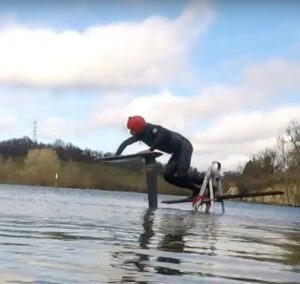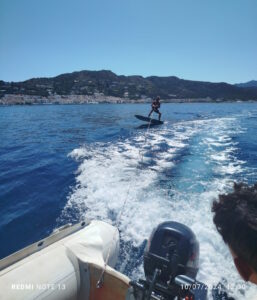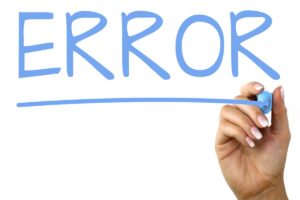It is the most important part of the foil (and the most expensive). There are 3 classifications:
- Low aspect (<5). Shorter and wider.

- High aspect (>7). Very long and less wide

- Mid aspect (5-7). An intermediate between the two
Low aspect or high aspect?
Many will tell you that if you want to learn quickly you should go straight to the high aspect and not waste time, but I learned with a low aspect and comparing the number of sessions with other people you don’t see that difference (in session 14 I was already 50 meters and managed to turn for the first time to return to the pier). I think there are other things that are more important when it comes to seeing how quickly people evolve, because I have seen people with high aspect who were worse in their 70th session than I was in my 11th session.
There are opinions for all tastes, but to start from scratch I recommend Low aspect for these reasons:
- They are safer.
- Low aspects tend to be shorter in span, so they stick out less of the water when the board tips over and it is a little easier to avoid the foil if you land near it.
- They don’t cut. Because they are thicker they don’t cut if you hit the foil, and when you start you are going to fall a lot.
- They are much cheaper. It is clear that over time you will want to move to a high aspect, to continue progressing and increase pumping time, but another clear advantage of low aspects is that they are much cheaper than high aspects, and there are more of them on the second hand market, so you can get one second hand and when you think it is time to change to a high aspect you can resell it without losing much money.
- They are easier to learn.
- If high aspects turn, they are harder to get back to the center and this makes it difficult to correct mistakes, and mistakes are very common for a beginner. Although there are many models within the high aspect class, this seems to be less true in some models than in others.
- HAs are more sensitive to a bad initial foot position.
- HAs require a smaller stabilizer and this will cause you to lose lateral stability for balance.
- HAs stop dead when you lose speed, so you will lose the opportunity to try to regain that speed that low aspects do give you.
- HAs require more speed. Many of the disadvantages I have mentioned so far are considerably reduced if you give the foil the necessary speed, but beginners will usually not know how to give it the necessary speed.
Just for the first one you should start with a low aspect without hesitation, but taking this into account I will give some references of what is usually recommended in both cases.
Low aspect
If you weigh around 70kg, a 1900cm2 wing is the minimum to learn well. If you weigh more, I would go up. In any case, if you have access to a foil with more area, I would take the one with the largest area you can, at the beginning any extra area will be welcome.. But don’t think that more area will do magic. With my 70kg, between my third and fourth session I changed from a 1900cm2 foil to a 2500cm2 foil and I didn’t notice a difference because I was still very green.
To give you some examples, in the Gong brand, the Allvator V1, Allvator Rise, and X-over models are sold a lot second hand. But any brand with these area sizes will give you a similar result for beginners.
High aspect
For people around 70kg I see that they are using wings with an area of approximately 1700cm2 (it needs less area than a low aspect for a similar lift) and a wingspan of between 105-115cm long. If you weigh more, people are already using areas of 2000cm2 and wingspans of 130cm.
If you want some examples, I’ll give you the most popular models I’m seeing from different brands for pump foil:
- Gong curve-h 3XL or more
- Gong sirux XL or more
- Gong fluid XXL or more
- Gong Veloce XXL
- Axis png 1150 or 1310
- Takuma kujira 1440 or more
- Sabfoil leviatan 1150 or more
- North Sonar…
- Cloud IX …
- Amstrong…
Be careful with the numbers in the sizes because some manufacturers refer to the span distance (winspan) and others to the area (cm2).




Hi Alain,
very compliments abd thanks for your guide, is very usefull! Unfurtunally a little convinced by Gael, a little convinced by the seller kiteworldshop, I bought it as a first set gear AFS Enduso 1600 GLT, full carbon ecc ecc…but now I’m not sure that I done the right choice to start learn pump….waht do you think about this?
Now I saw the Gong Foil Trail V3 – Alu 70, what do you think about this set?
Thank you very much
Mattia
I actually tried the AFS Enduro 1600 this past weekend, and it’s not an easy foil at all. So I don’t see it as suitable for beginners. Although I should mention that the person who lent it to me learned with it, so it’s possible to learn with it, although in my opinion it will take you considerably longer.
I haven’t tried the Gong Trail foils, but they say they’re good for learning. If you can buy a used one, I think it would be a good option, but I wouldn’t buy a new one, because as soon as you learn, you’ll want to sell it and buy a more advanced one.
If you buy this one used, or an older low-aspect foil of any brand but with a large area (I used the Gong Rise XXL), you’ll learn easily and then sell it again without losing money.
Since I can’t practice very often, I think it would take me too long with the Enduro… I’d save it for when I’ve learned a bit. Would it be a good next step?
Would the Rise XXL gong be good for my weight of 72-73 kg? Or is the XL better?
If you know of any sites/online markets I could look at.
Thanks so much for the advice.
It will be a good foil for intermediate/expert level if you want a foil with a lot of speed and fun, but if you want a foil to pump slow and long I dont find it good.
Rise XXL better, my weigth is 70kg, with the xl it would be possible but a bit more difficult.
where are you from? in spain the best one is wallapop in france leboncoin… in each country the best webpage is different.
I will take it for the future 🙂 because I paid a lot for it 🙁 , ah, I have stab silk 40…
I’m in Italy…
Thank you again